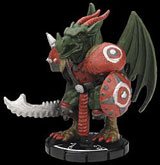 Even if it were a lousy game, Mage Knight: Rebellion would have
been a stroke of marketing genius. That's because Mage Knight combines some of the best
qualities of such wildly popular collectable card games as Magic: The Gathering with those
of such wildly popular fantasy miniatures games as Warhammer, and thus manages to
capitalize on both the current mania for collectability as well as the table-top allure of
miniatures games. This all adds up to a new genre, the Collectable Miniature Game, and
frankly you've got to wonder why nobody thought of this before. Even if it were a lousy game, Mage Knight: Rebellion would have
been a stroke of marketing genius. That's because Mage Knight combines some of the best
qualities of such wildly popular collectable card games as Magic: The Gathering with those
of such wildly popular fantasy miniatures games as Warhammer, and thus manages to
capitalize on both the current mania for collectability as well as the table-top allure of
miniatures games. This all adds up to a new genre, the Collectable Miniature Game, and
frankly you've got to wonder why nobody thought of this before. But Mage Knight is more than just a marketing
gimmick--it's an excellent game. It's easy enough for even fairly young children to learn,
yet offers enough tactical possibilities to keep even hardened grognards happy.
The game is fast and fun, and the innovative combat dial base dispenses with the tedious
bookkeeping that so many miniatures games require. Finally, Mage Knight is (so far as
miniatures goes) cheap. While assembling a viable Warhammer army will run you several
hundred dollars, you can play a rousing game of Mage Knight with the stuff that comes in
the $18 starter box.
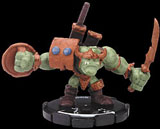 Mage
Knight is sold in starter sets and booster packs (which retail for $6.50), though army
kits with specific "common" figures will soon be available. The starter set comes with ten randomly packaged painted and assembled
miniature figures, a 12-page rule booklet, a special abilities reference card, a comic
book, two six-sided dice, and an 18” tape ruler. That's everything you need to play
the game (except an opponent with their own starter set)--there are no add-ons or extra
books to purchase, no extra equipment needed. Of course, since there are 160 different
figures (not quite the truth, more on this later) to collect of varying degrees of rarity,
you'll want to pick up extra booster packs, which contain five randomly packaged figures. Mage
Knight is sold in starter sets and booster packs (which retail for $6.50), though army
kits with specific "common" figures will soon be available. The starter set comes with ten randomly packaged painted and assembled
miniature figures, a 12-page rule booklet, a special abilities reference card, a comic
book, two six-sided dice, and an 18” tape ruler. That's everything you need to play
the game (except an opponent with their own starter set)--there are no add-ons or extra
books to purchase, no extra equipment needed. Of course, since there are 160 different
figures (not quite the truth, more on this later) to collect of varying degrees of rarity,
you'll want to pick up extra booster packs, which contain five randomly packaged figures.
The figures are of a size similar to Warhammer and Warhammer 40K figures--about 25 to 28mm
scale, and represent warriors from eight different "factions"--the Atlantis
Guild, the Elemental League, the Necropolis Sect, The Black Powder Rebels, the Knights
Immortal, The Orc Raiders, the Draconum, and the Mage Spawn. Each faction has its own
personality and special abilities, though most have some sort of close-combat warrior,
ranged-attack warrior, healer and magic user. You may choose to assemble your Mage Knight
army from several different factions, or limit armies to figures from just one faction.
This allows for a lot of mixing and matching, and offers many different tactical
combinations.
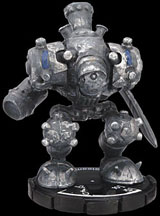 The most
ingenious thing about the Mage Knight figures is the base, which contains the game's
innovative combat dial. The dial's stat slot shows all a figure's vital statistics--speed,
range, attack value, defense value, damage value. As your figure takes damage, you twist
the dial to "click down" the number of damage points you've taken. This will
change the values in the stat slot, usually (but not always) for the worse. The numbers in
the stat slot are sometimes color-coded as well, which indicates that the figure has a
"special ability." There are 28 of these different abilities, ranging from Magic
Blast to Magic Immunity to Vampirism to Berserk, and they're a very effective and simple
way of adding variety to the units and color to the game. Though initially you'll have to
look up these effects on the special abilities card, after a few games the color-coding
becomes second nature. Each figure is also given a point value, with very weak units in
the single digits and some of the imposing Draconum units valued at around 140 or so. The most
ingenious thing about the Mage Knight figures is the base, which contains the game's
innovative combat dial. The dial's stat slot shows all a figure's vital statistics--speed,
range, attack value, defense value, damage value. As your figure takes damage, you twist
the dial to "click down" the number of damage points you've taken. This will
change the values in the stat slot, usually (but not always) for the worse. The numbers in
the stat slot are sometimes color-coded as well, which indicates that the figure has a
"special ability." There are 28 of these different abilities, ranging from Magic
Blast to Magic Immunity to Vampirism to Berserk, and they're a very effective and simple
way of adding variety to the units and color to the game. Though initially you'll have to
look up these effects on the special abilities card, after a few games the color-coding
becomes second nature. Each figure is also given a point value, with very weak units in
the single digits and some of the imposing Draconum units valued at around 140 or so.
Mage Knight games are very fast-moving. The standard game uses only 200 points
worth of figures (usually from five to a dozen figures), and each player's turn is made up
of one "action" per 100 points of figures, though some special abilities can
increase the number of actions allowed. An action permits you to move, attack with, or use
the special ability of one figure, though using "formations" can allow you to
move or attack with several figures per action. The same figure cannot use an action in
two consecutive turns without taking a point of damage. These limitations make most Mage
Knight games real chess matches--the rules are deceptively simple and easy to learn, but
there's a lot of hidden depth as well. Combat is simplicity itself--you roll 2D6 and add
them to your attack factor--if that beats your enemy's defense rating, you do your damage
factor's worth of damage to their figure. Points are awarded for enemy units killed and
captured, and deducted for your own army's losses.
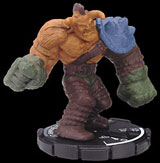 The rules
are well-written and clear, though they're not quite as well-organized as I'd have liked.
It pays to read the whole booklet through a few times before beginning. And though the
rules are comprehensive, they're lacking any sort of suggestions for scenarios besides the
"standard" line 'em up and shoot 'em down game, and there's very little fluff.
If Mage Knight becomes the hit I expect it to--and the stores can't keep it on the
shelves in my area--this should change, and the Mage Knight web site (www.mageknight.com)
already has plenty of background up. The rules
are well-written and clear, though they're not quite as well-organized as I'd have liked.
It pays to read the whole booklet through a few times before beginning. And though the
rules are comprehensive, they're lacking any sort of suggestions for scenarios besides the
"standard" line 'em up and shoot 'em down game, and there's very little fluff.
If Mage Knight becomes the hit I expect it to--and the stores can't keep it on the
shelves in my area--this should change, and the Mage Knight web site (www.mageknight.com)
already has plenty of background up.
Another thing that could stand a little
changing is the quality of the figures. While most of them are acceptably modeled--and
some of them are quite good--don't expect Games Workshop standards. On the other hand, the
paint jobs on the figures range from merely competent to really terrible. While this is
perhaps understandable given the price of the figures and the fact that WizKids encourages
players to repaint their army if they wish, a dash more quality control wouldn't hurt at
all. Overall, the figures get the job done. And while WizKids claims that there are
160 different figures, that's a little creative--many of the figures come in three
different colors, with three different stats lines--but they're the same model. The only
other quibble I have with Mage Knight is that the combat dial's stats slot is placed on
the front of the figure bases; it would have been much easier to read (especially in the
heat of combat) if it had been placed on the back.
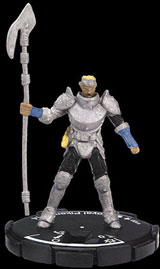 But that's about all I have to complain about. I'm a big Mage
Knight fan, mostly because it's a fun, colorful game I can play with my two sons, ages
seven and eleven. Again, this is one of the most remarkable things about the game. When I
first saw that it was recommended for ages 8 and up, my reaction was that it must be a
pretty simple (i.e., dull). But--like most excellent games--Mage Knight manages to combine
simple mechanics with deep gameplay. Add to this affordability and the fun of trading for
those really rare figures (anyone out there got an Paladin Prince?) and Mage Knight may
well be bound for a place in the gaming pantheon alongside such stalwarts as Magic,
Pokemon, Warhammer, and D&D. But that's about all I have to complain about. I'm a big Mage
Knight fan, mostly because it's a fun, colorful game I can play with my two sons, ages
seven and eleven. Again, this is one of the most remarkable things about the game. When I
first saw that it was recommended for ages 8 and up, my reaction was that it must be a
pretty simple (i.e., dull). But--like most excellent games--Mage Knight manages to combine
simple mechanics with deep gameplay. Add to this affordability and the fun of trading for
those really rare figures (anyone out there got an Paladin Prince?) and Mage Knight may
well be bound for a place in the gaming pantheon alongside such stalwarts as Magic,
Pokemon, Warhammer, and D&D.
Rick
Fehrenbacher |
